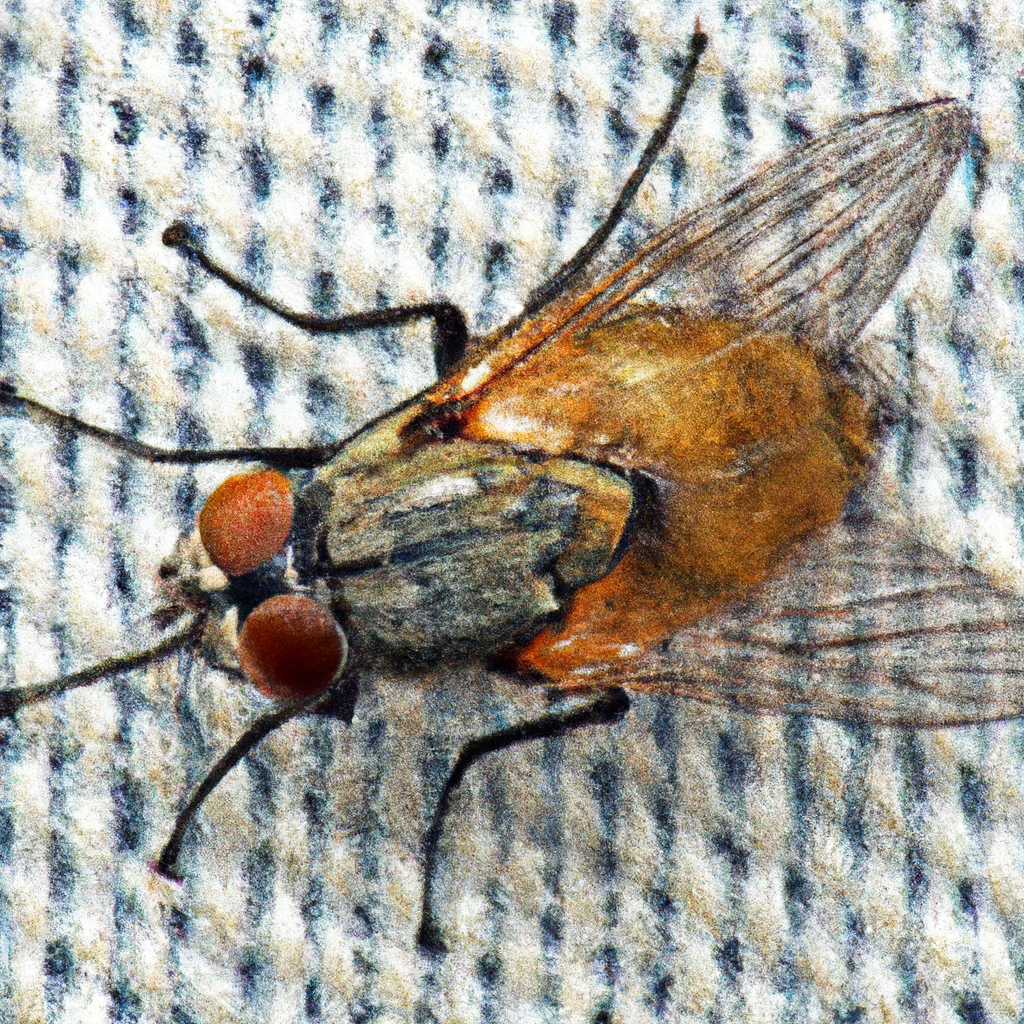Have you ever found yourself wondering what common house flies actually look like? Well, you’re in luck! In this article, we will explore the various characteristics and physical features of these pesky insects. From their distinctive body structure to their notable wing patterns, we’ll help you become an expert in identifying common house flies. So, let’s dive right in and discover the fascinating world of these winged creatures that we often encounter in our daily lives.
Common House Flies Identification
If you’ve ever encountered a pesky fly buzzing around your home, chances are it was a common house fly. These insects are a familiar sight in many households, but how well do you really know them? In this article, we will explore the physical characteristics, life cycle, habitat, behavior, health concerns, and prevention methods associated with common house flies. So, let’s dive in and learn more about these winged nuisances!
Physical Characteristics
Size
When it comes to size, common house flies are relatively small insects. They typically measure between 6 to 7 millimeters in length. While this may seem tiny, their ability to maneuver swiftly makes up for their size. So, don’t be fooled by their small stature – these flies can zip around with impressive agility!
Color
The coloration of common house flies is quite distinctive. Their bodies are usually gray or dull brown, providing excellent camouflage on surfaces like walls and countertops. You may also notice black stripes on their thorax, giving them a slightly striped appearance. Additionally, some flakes on their wings might create a shimmering appearance in certain lighting conditions.
Wings
One of the most recognizable features of house flies is their transparent wings. When at rest, these wings are typically held flat over their body, overlapping slightly. The wingspan of a common house fly can reach up to 13 millimeters, allowing them to generate a characteristic buzzing sound as they fly around.
Eyes
House flies have large compound eyes, which are made up of thousands of individual lenses called ommatidia. These eyes provide them with a wide field of vision, enabling them to detect movement and potential threats from various directions. Their eyes are reddish-brown in color, but they might appear darker due to their size and the pattern of the faceted lenses.
House Flies vs. Other Fly Species
While all flies may seem similar at first glance, there are distinguishing features that set common house flies apart from other species. Understanding these differences can help you identify the specific type of fly you are dealing with.
Distinguishing Features
One key feature that differentiates common house flies from other flies is their thorax coloration. House flies typically possess four black longitudinal stripes on their gray or dull brown thorax. This distinct marking is absent in many other fly species, making it a useful characteristic to look for.
Differences in Appearance
Apart from their identifying thorax stripes, house flies also differ from other species in terms of body shape and size. They are generally smaller than some of their close relatives, such as horse flies or blow flies. Furthermore, their body color tends to be more muted compared to the vibrant hues found in certain other species. These differences in appearance can be helpful when trying to determine the type of fly you are encountering.

Life Cycle of Common House Flies
To better understand the behavior and habits of common house flies, it is essential to delve into their life cycle. Like many insects, house flies go through four distinct stages of development.
Egg Stage
The life cycle begins with the egg stage. Female house flies lay their eggs, usually in decaying organic matter, such as garbage, animal waste, or compost piles. A single female can lay hundreds of eggs during her short lifespan. These tiny, oval-shaped eggs are typically whitish and measure around 1.2 millimeters in length.
Larva Stage
After approximately 12 to 24 hours, the eggs hatch into larvae, commonly known as maggots. The larvae are cream-colored and legless, with a cylindrical body that tapers toward the head. They feed voraciously on organic matter, breaking it down into more manageable pieces. This stage lasts for about 3 to 5 days, during which the larvae undergo several molts to grow larger.
Pupa Stage
Once the larvae have completed their feeding phase, they enter the pupal stage. At this stage, the larvae transform into pupae by enclosing themselves in a protective casing known as a puparium. Inside the puparium, they undergo metamorphosis, where their body structure and features transform. This non-feeding stage usually lasts for about 3 to 6 days, depending on environmental conditions such as temperature.
Adult Stage
Finally, it is time for the emergence of adult house flies. When the transformation is complete, the adult flies break out of the puparium. Initially, their bodies are soft and pale, but within a few hours, they darken and harden. The adults then become ready for reproduction and join the other house flies in their buzzing pursuits.
Habitat and Distribution
Understanding the preferred environments and global distribution of common house flies can shed light on why these insects seem to be everywhere.
Preferred Environments
House flies thrive in warm, moist environments abundant in organic matter. They are especially attracted to decaying food, animal waste, and exposed garbage. These ample sources of food and breeding sites can be found in kitchens, trash cans, and outdoor areas like compost heaps or animal shelters. Thus, maintaining cleanliness and proper waste management is crucial in reducing their presence.
Global Distribution
Due to their adaptive nature, common house flies are found worldwide, except in extreme cold or arid regions. They are prevalent in both urban and rural areas, taking advantage of human settlements and agricultural practices. Whether you live in North America, Europe, Asia, or elsewhere, chances are you have encountered these ubiquitous insects.

Behavior and Habits
Observing the behavior and habits of common house flies can provide valuable insight into their daily activities and interactions.
Feeding Habits
House flies are known for their feeding habits, which can be quite unappetizing to humans. These opportunistic insects feed on a wide range of organic materials, including rotting fruits and vegetables, animal feces, and even decaying corpses. By liquefying their food with digestive enzymes and sucking it up, house flies can consume a variety of unsavory substances.
Breeding Behavior
When it comes to breeding, house flies are highly prolific. They reproduce through sexual reproduction, with males and females engaging in a brief mating ritual. Interestingly, males produce a pheromone that attracts females, and the mating process can last as little as a few seconds. After mating, females seek out suitable sites to deposit their eggs, usually near food sources in dark and moist areas.
Migratory Patterns
While house flies may not exhibit long-distance migrations like birds or butterflies, they can travel significant distances within their local habitats. Flies can move from one food source to another, seeking out suitable breeding grounds or more favorable conditions. Their ability to cover short distances quickly allows them to explore different areas and potentially infest new locations if conditions are suitable.
Health Concerns and Diseases
House flies have long been associated with various health concerns and the transmission of diseases. Understanding their role as disease vectors and the potential health risks they pose is crucial for prioritizing prevention measures.
Role as Disease Vectors
House flies can pick up disease-causing microorganisms and pathogens from their feeding sites, particularly in unsanitary conditions. These organisms can then be transferred to human food, utensils, or surfaces through contact with fly body parts or feces. Diseases such as food poisoning, diarrhea, and dysentery have been linked to the presence of house flies, making them an important target for pest control.
Potential Health Risks
The presence of house flies in homes or food establishments can compromise the safety and hygiene of the environment. Contamination can occur through direct contact with flies or indirectly through the surfaces they come into contact with. In addition to bacterial diseases, they can also transmit parasitic infections like intestinal worms. Hence, it is essential to take measures to prevent infestations and minimize the health risks associated with house flies.
Preventing House Fly Infestations
Luckily, there are several steps you can take to prevent house fly infestations in your home or workplace. By implementing proper sanitation measures and exclusion techniques, you can greatly reduce the attraction and entry of these bothersome insects.
Sanitation Measures
Maintaining high levels of cleanliness is paramount in deterring house flies. Ensure that all food is properly stored in sealed containers and promptly dispose of any organic waste in tightly sealed garbage bins. Regularly clean garbage cans and other potential breeding sites to eliminate fly eggs and larvae. Additionally, keep your kitchen and dining areas clean and free from crumbs or spills that may attract flies.
Exclusion Techniques
Preventing house flies from entering your living or working spaces can be achieved through various exclusion techniques. Install screens on doors and windows to create a barrier that prevents flies from entering while still allowing fresh air circulation. Seal cracks or gaps in walls and windows to eliminate potential entry points. If you have outdoor areas prone to infestations, such as compost piles, consider covering them or using preventive measures like fly-proof netting.
Home Remedies and Non-Chemical Control Methods
If you prefer to avoid using chemical-based products, there are several home remedies and non-chemical control methods that can help manage house flies.
Fly Traps
Fly traps can be an effective and non-toxic way to catch and eliminate house flies. There are various types of fly traps available, including sticky traps or traps that use attractants to lure the flies. These traps can be placed in areas where fly activity is high, such as near garbage bins or food preparation areas.
Fly Repellents
Natural fly repellents made from essential oils or herbs can provide a temporary solution to deter flies from certain areas. Common repellents include lavender, eucalyptus, or mint. These can be used in the form of sprays or soaked cotton balls strategically placed in fly-prone areas. However, it’s important to note that these remedies might not be as effective as chemical-based repellents or professional pest control methods.
Chemical Control Methods
When all else fails, or when dealing with severe infestations, chemical control methods may be necessary to effectively eliminate house flies.
Insecticides
Insecticides designed specifically for house flies can be applied to targeted areas to kill adult flies, larvae, or eggs. These products typically come in sprays, aerosols, or baits. It is crucial to follow the instructions carefully and adhere to safety precautions when using chemical insecticides to avoid any risks to humans, pets, or the environment.
Professional Pest Control
For persistent or large-scale infestations, it is advisable to seek professional pest control services. Pest control professionals have the expertise, knowledge, and access to commercial-grade treatments that can effectively eliminate house flies and prevent future infestations. Consulting with a professional ensures that the correct methods are employed and that the safety of your environment is prioritized.
Conclusion
By now, you should have a comprehensive understanding of common house flies, their physical characteristics, life cycle, habitat, behavior, health concerns, and prevention methods. While these insects may be a nuisance, their presence can be controlled and mitigated through proper sanitation measures, exclusion techniques, and, if necessary, chemical control methods. Remember to maintain cleanliness, eliminate breeding sites, and take proactive steps to keep these winged pests at bay. With a little diligence and effort, you can enjoy a fly-free environment that promotes the well-being and health of yourself and your loved ones.




